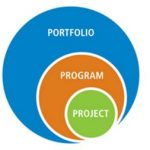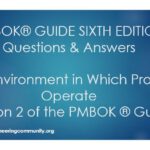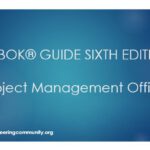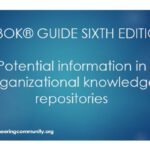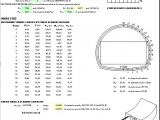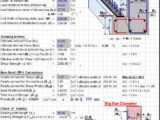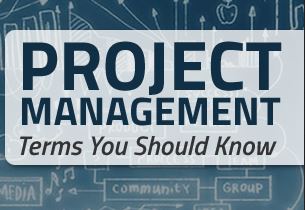
The most important key words for PMP exam
27 June 2020The most important key words for PMP exam
1- Discussing about agile and waterfall (Project life cycle)
2- Person change charter (sponsor)
3- Tools for mange contract and procurement documentation (record management system)
4- Prevent scope creep (scope management plan)
5- Generate information (Brainstorming)
6- Generate and organize or grouping or classifying information (Affinity diagram)
7- Generate and prioritization (Nominal group technique)
8- Buffers, limited resources, project uncertainties (Critical chain method)
9- Project terminated because problem in credit in the bank (Funding Limit Reconciliation)
10- Project team leaves the site early (Ground rules)
11- Long-term resolution (Problem solving)
12- One of sh not received reports and others received (Review the communication management plan)
13- Greatest potential Risk to your project (Tornado Diagram)
14- The team has told you that, the cement will delay (Workaround)
15- Insurance (Transference)
16- Identify new risk and close the outdated risk (Risk reassessment)
17- Effectiveness of risk responses (Risk audits)
18- The contract will span multiple years and allow for final price adjustments based on changing conditions (Fixed Price with Economic Price Adjustment)
19- A concrete mix ( 101)
20- Classifying the identified stakeholders (power/ interest grid)
21- Links product requirements from their origin to the deliverables (Requirements traceability matrix)
22- Strike by local workers (What-If Scenario)
23- Prevent cost overrun (change management plan)
24- A method that doesn’t consider the risk ( Triangular distribution)
25- Discuss the Strategic Direction (the sponsor)
26- Discuss the implementation strategy (PM)
27- Reason why the project is authorized (Business case)
28- Frequency &largest to smallest (Pareto diagram)
29- SH roles (SH register)
30- Training is an example of (Prevention cost)
31- Least flexibility (CPM)
32- Stability process ,control limits or 7 rules (control charts)
33- Determine true magnitude (WBS)
34- Uncontrolled changes (scope creep)
35- Estimate the cost of quality in a process (flow chart)
36- Identify new risk during execution (risk audits)
37- Links product requirements to origin deliverables ( treacibility matrix)
38- Labors strike (what-if-analysis)
39- Relation problems (stakeholder management plan)
40- Information problems (communication management plan)
41- Narrative description (SOW)
42- Why the project is authorized (business case)
43- Frequency of occurrence, ranging from greater to smaller , ranking, 80/20 (Pareto diagram)
44- Active acceptance (contingency reserves)
45- Passive acceptance (management reserves)
46- One line or linear (triangular distribution)
47- Formal acceptance (validate scope)
48- Final acceptance (close project or phase)
49- Training (prevention cost)
50- Identify success and failures of procurement contracts (procurement audit)
51- Estimating cost using WBS (bottom-up estimating)
52- Strategic directions (the sponsor)
53- Implementation directions (PM)
54- Snapshot of the status of various projects (milestone chart)
55- Linked to potential problems, root causes (cause and defect diagram)
56- No bias, Consensus or SME (Delphi)
57- The point where budget is compared to earned value for performance measurements (control accounts)
58- Statical relationships between the historical data and other variables (parametric estimating)
59- Collect requirements (T&T)
Focus group (prequalified, SME)
Facilitated groups (key stakeholders, improve communications, increase consensus, discovered earlier and quickly, QFD, User stories) Interviews (elicit information directly, obtaining confidential information)
Group Creativity Techniques
Brainstorming (generate and collect)
Nominal group technique (enhances brainstorming, Voting, Ranking and Prioritize)
Affinity diagram (large numbers, classified into groups)
60- Risk reassessment (new risks-current risk evaluates-outdated risks)
61- Risk audit (effectiveness of risk response-identified risks with their root causes-the effectiveness of the risk management process)
62- CPIF contracts (sharing ratio)
63- FIXED Price (risk on seller)
64- Cost plus (risk on buyer)
65- Risk appetite (willing, a reward)
66- Risk tolerance (withstand)
67- Risk threshold ( level of uncertainty, level of impact, LIMITS)
68- Communication management plan (Escalation, confidential information)
69- Requirements traceability matrix (links product requirements from their origin to the deliverables)
70- Identify factors that may influence (DOE)
71- Team development
Forming (the team members work independently)
Storming (the team begins to understand the project work)
Norming (the team begins to learn from one another)
Performing (work as a well-organized unit and reach maximum performance)
Adjourning (the team completes the work)
72- Discover the underlying causes for RISK (Root cause analysis)
73- Organizational structure (EEF)
74- Inspection (Control Quality)
75- Control communications, summary activity, used between milestones or work package (Hammok activity)
76- Resource smoothing ( no affecting the critical path)
77- Resource leveling (may impact the critical path)
78- Project boundaries (a point in time that a project is authorized to its completion)
79- Issue log (current issue, problems)
80- Control quality (the team is doing the testing)
81- Validate scope (the customer is doing the testing)
82- Project performance appraisal (individual team member’s performance)
83- Team performance assessment (assessment of project team’s effectiveness)
84- Repetitive activities, 7 rules, limits (control limits)
85- Trend analysis (comparison of future performance with current performance)
86- Prioritize risks (qualitative risk analysis)
87- Soft logic (discretionary dependency)
88- Balanced matrix (both functional and project managers share the responsibility)
89- Quality assurance (improve quality processes)
90- Develop team (Recognition and rewards, training)
91- Change management plan, forecasting (cost overrun)

